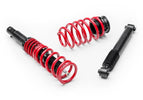
Coilovers Clunking? | Suspension Trouble Shooting
, by Raceland Europe Admin, 4 min reading time

, by Raceland Europe Admin, 4 min reading time
So, you’ve installed your new suspension parts only to hear new squeaks and clunks that weren’t there before. It can be aggravating to have to deal with unexpected problems. In this post, we’ll help list possible problems and fixes as a way to educate those that haven’t upgraded their suspension yet. To those that have already upgraded and are having issues, we hope this post will serve as a trouble shooting guide so that you can resolve the issue start enjoying your new parts.
The first thing to keep in mind is that bushings, most often made of rubber, make up a critical part of your suspension. The bushings provide a cushion for the suspension and help to reduce NVH (Noise, Vibration, & Harshness). This helps keep the suspension comfortable, quiet, and long lasting.
With that said, the bushings are wear items and will eventually need to be replaced. Some of those bushings include:
When bushings become worn out, they can have excess play which decreases performance and will cause the suspension to become noisier. When suspension components like coilovers or stiffer sway bars are installed, the stiffer added component can make any existing issue more evident or help in making worn components wear to the point of failure or noise.
Most of the time when we hear complaints of noises happening immediately after installation it will, in most cases, point directly to the installation itself. If your new suspension has not been installed correctly or parts are out of order it will almost always result in noise and performance issues. Check the installation against installation manuals and factory component orientation to ensure everything is being installed correctly.
When something was changed such as installing a stiffer sway bar or new suspension, it can alter the dynamic of the suspension and put more stress on worn and failing bushings. Check the bushings mentioned above for obvious signs of dry rot, stress cracks, or worn/torn portions. If any of these issues are evident, replace the problematic bushing(s). It helps to assess what type of noise you are hearing…
Clunk - If there is a clunk and you have confirmed that installation was done correctly, there is play somewhere in the suspension or there may be suspension components coming in contact with other components. The play often comes in the form of a worn bushing(s) while components contacting each other often happens after a vehicle’s ride height is raised or lowered.
As mentioned above, look for failing bushings and consider replacing the likely worn bushing(s). In the case that there is contact between suspension parts, you’ll need to assess what parts are contacting and how the suspension geometry can be changed to move these components away from each other. This can often be done with adjustable components such as adjustable end links, adjustable control arms and/or adjustable sway bars.
Squeak - Squeaks, most often, originate from rubber components or contact points where two components of the same material are touching another. Check all rubber components for wear or to see if they need to be lubricated. When lubricating bushings, lubricants like silicone grease will be longer lasting than other general lubricant options like WD-40.
If you are having two components of the same material (ie steel to steel or rubber to rubber) touching and making noise, ensure that you have installed all components in the proper order. It isn’t common to have two like materials touching as there will often be buffer like rubber or plastic between metal components. A good example of this is a spring to control arm contact point. There almost always will be a rubber isolator between the two. Check all contact points for problematic areas.
Popping - Specifically when steering, if you're hearing any popping noises, it is very likely that the upper strut mount bearings are worn out. These bearings help to keep the suspension moving together and when they are worn out, it causes the top or bottom of the spring to not turn with the rest of the suspension with movement of the steering wheel. We highly recommend replacing any worn upper strut mount bearings as soon as possible as damage can be done to other suspension components, including the shocks of the vehicle.
In the end, seeking the help of an experienced professional will be your best bet in resolving any issues. With that said, several of the mentioned fixes above can be done with a little know-how and will save you money in the long run.


